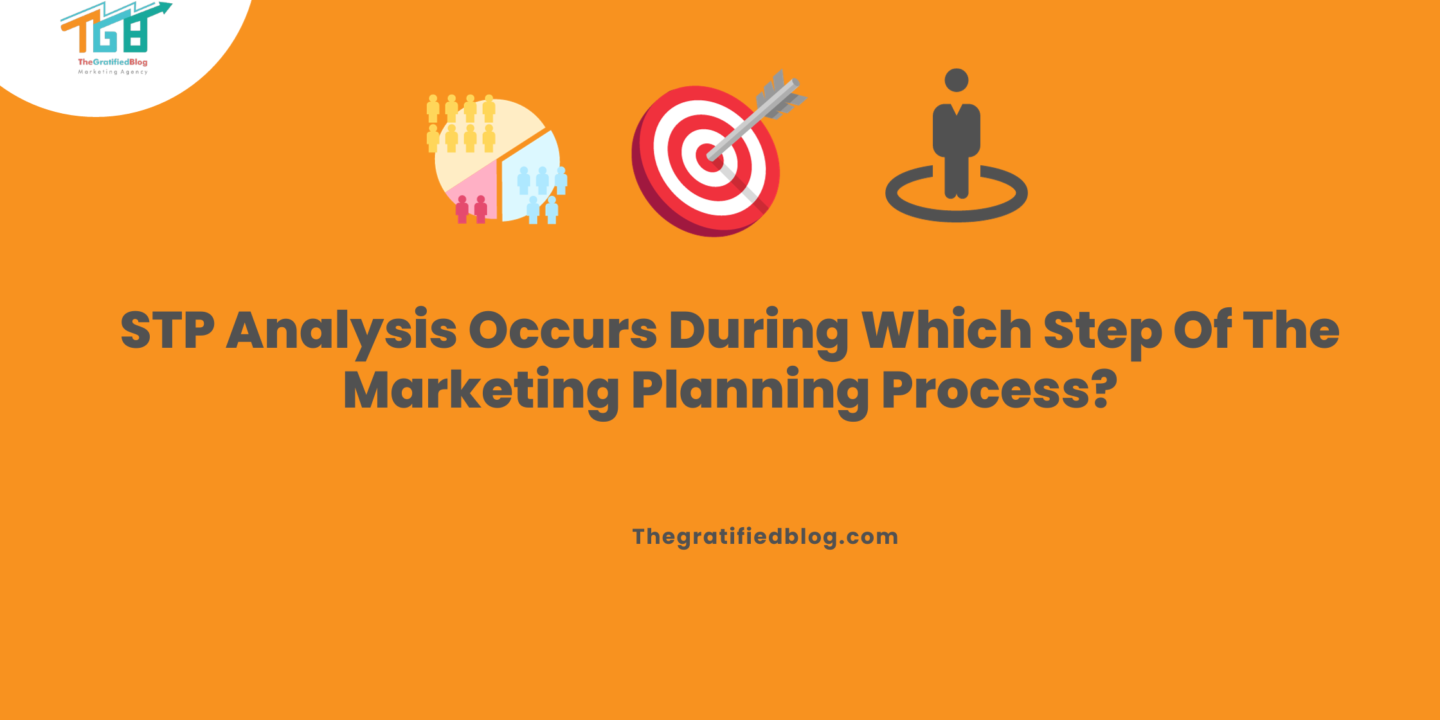
Marketing is a complex web of strategies and tactics aimed at capturing the hearts and minds of consumers. Businesses turn to a structured framework, the marketing planning process, to navigate this intricate landscape effectively. Within this process, there lies a critical component: STP analysis. But where does this analysis fit within the marketing planning process, and why is it vital?
Within this blog, we will respond to the pressing query, “STP analysis occurs during which step of the marketing planning process?” as we unravel the layers of marketing strategy, unveiling the role of STP analysis in crafting successful marketing campaigns.
So, let’s get started by answering the question:
STP Analysis Occurs During Which Step Of The Marketing Planning Process?
Answer: Targeting
STP analysis indeed occurs during the targeting phase of the marketing planning process. But to truly understand its significance and how it fits into the broader marketing context, we must thoroughly explore the entire process.
So, let’s dive in:
The Marketing Planning Process

This process typically consists of five phases, and STP analysis takes center stage at a pivotal point in this journey.
Phase 1: Understanding The Market
This initial phase of the marketing planning process is all about gaining a deep understanding of the market in which your business operates. It consists of two essential steps:
Market Research and Situation Analysis
The marketing planning process begins with a crucial first step: comprehensive market research and situation analysis. This phase involves meticulous data collection and in-depth analysis to understand various critical factors better.
These include current market conditions, consumer behaviors, and the competitive landscape. By diving into market research, you’re scratching the surface and digging deeper to uncover valuable insights. These insights encompass emerging market trends, consumer preferences, and the strategies deployed by your competitors. This wealth of data is the bedrock for making informed, strategic decisions and crafting effective marketing campaigns that resonate with your target audience.
Setting Objectives and Goals
With your arsenal of market research insights, the next step is setting explicit and measurable marketing objectives and goals. These objectives act as the guiding lights for your marketing endeavors. They’re the destination points, clearly outlining what you aspire to achieve.
Whether you focus on increasing market share, boosting sales, expanding into new territories, or enhancing brand visibility, these objectives serve as the compass, ensuring every subsequent action and strategy is purposeful and aligned with your overarching mission. Essentially, they provide the direction and purpose that steer your entire marketing strategy, ultimately leading you to attain your goals successfully.
Phase 2: Segmenting, Targeting, And Positioning
This phase is pivotal in creating a successful marketing strategy. Here, businesses focus on understanding their target audience and how to reach best and influence them. It consists of three key components:
- Market Segmentation: Market segmentation divides a broad market into smaller, more manageable groups with shared characteristics, needs, or behaviors. The goal is to create distinct customer segments for customized marketing strategies. For instance, a clothing retailer might segment their market by age and gender to tailor clothing lines to specific customer groups.
- Targeting involves choosing which market segments to focus your marketing efforts on. This step requires evaluating each segment’s potential and selecting the ones offering the best opportunities for success. In the clothing retailer example, they target young, fashion-forward, sustainability-conscious adults if this segment presents high potential.
- Positioning: It’s all about crafting a unique brand image that resonates with the selected target audience. The objective is to set your brand apart from competitors in consumers’ minds, creating a compelling and memorable identity. In the case of the clothing retailer, their positioning strategy might emphasize sustainability, high quality, and affordability to set them apart from other competitors in the market.
Phase 3: Crafting The Marketing Mix
This phase holds significance as it enables the business to establish product offerings, pricing strategies, distribution channels, and promotional efforts.
- Product: Tailoring your product or service offerings is meeting your chosen market segments’ specific needs and preferences. This can involve developing entirely new products, tweaking existing ones, or customizing features to align with the identified target audience. In essence, it’s about ensuring that what you offer is a perfect match for what your customers are looking for.
- Price: Setting pricing strategies is a critical component of marketing. It involves adjusting prices to cater to your selected market segments’ price sensitivity and buying capacity. Depending on your audience, this might mean offering competitive pricing, premium pricing for high-end products, discounts to attract budget-conscious consumers, or a range of pricing options to suit various customer groups.
- Place: Determining the most effective distribution channels ensures that your products or services are accessible to your target audience readily. It entails considering online and offline distribution, direct sales, retail partnerships, and other factors. The goal is to make your offerings available where your chosen segments prefer to shop or access services.
- Promotion: Promotion is the art of developing marketing and promotional strategies that connect with the characteristics and behaviors of your market segments. It entails creating advertising campaigns, content, and messaging that engage and appeal specifically to the identified target audience. Effective promotion communicates the value of your products or services in a manner that strikes a chord with your customers and encourages them to take action.
Phase 4: Execution And Assessment
In this phase, Implementation is the critical step where your carefully crafted marketing plan transitions from theory to practice. During this phase, the strategies and tactics are implemented, ensuring they are put into action effectively. To do this:
- Execution of Marketing Strategies: This phase focuses on implementing your carefully planned marketing strategies. It includes launching advertising campaigns, creating content, setting up distribution channels, and all other practical steps required to implement your marketing strategy effectively.
- Assessment and Monitoring: Concurrently with execution, assessment and monitoring are essential. This involves tracking the progress of your marketing efforts and continuously evaluating key performance indicators (KPIs) like website traffic, conversion rates, sales, and other relevant metrics. Regular assessments help gauge your strategies’ effectiveness and identify improvement areas.
Phase 5: Adaptation And Optimization
In the final phase of the marketing planning process, businesses focus on adaptation and optimization. This phase involves two key activities:
Adjustment and Optimization: Businesses utilize the insights gained from monitoring and evaluation to pinpoint areas where their marketing strategy might require refinement or enhancement. This could encompass various changes, from fine-tuning advertising campaigns to modifying product features, pricing strategies, or distribution channels. The ultimate objective is to boost the overall effectiveness of the marketing strategy, aligning it more closely with the desired objectives and goals.
Adjusting to evolving market conditions and shifts in consumer preferences: The business landscape is in constant flux, with market conditions changing rapidly and consumer preferences evolving. To maintain the effectiveness of the marketing strategy, it’s essential to adapt to these shifts. This may involve reallocating resources to emerging markets, responding to industry trends, or incorporating innovative technologies. Remaining adaptable and responsive to the ever-evolving landscape is critical to achieving long-term marketing success.
Now that we have delved into the comprehensive marketing planning process let’s look at STP analysis and its significance within this broader framework.
The Significance Of STP Analysis
STP analysis, which stands for Segmentation, Targeting, and Positioning, is a structured marketing approach that helps businesses identify the most suitable customer segments and create marketing strategies that resonate with those segments.
Segmentation
Segmentation is the first phase of STP analysis. The market is divided into smaller segments based on specific criteria such as demographics, psychographics, behaviors, or geographic locations. This step is essential because it allows you to create a comprehensive picture of your potential customers and understand their diverse needs and preferences.
For example, a clothing retailer might segment its market based on age, gender, and style preferences to tailor their offerings accordingly.
Targeting
During this stage, you assess the market segments pinpointed in the segmentation process, determining which ones hold the most promise and are in sync with your business objectives. In this phase, you decide where to concentrate your resources and marketing endeavors. To illustrate, using our clothing retailer example, if their research shows that sustainability-conscious young adults represent a lucrative segment, they will make this group their primary focus.
Positioning
Positioning is the final phase of STP analysis. After selecting the target segments, you must establish a unique and compelling brand position within the minds of your chosen audience. Your positioning strategy should communicate the distinct value your product or service provides compared to competitors. For our clothing retailer, the positioning strategy might revolve around sustainability, quality, and affordable pricing, catering to the preferences of their selected target audience.
Now that we’ve established when STP analysis takes place, and its importance let’s delve into how STP analysis plays a pivotal role in achieving marketing success. We’ll explore this through real-life examples to gain a deeper understanding.
The Role Of STP Analysis In Marketing Success
STP analysis plays a pivotal role in the success of marketing campaigns and overall business performance. Let’s explore how each component of STP contributes to this success:
- Segmentation: Segmentation provides a profound understanding of your customers by dividing the market into distinct groups. This division enables the creation of tailored marketing messages and product offerings that cater to each segment’s unique needs and desires. The result is heightened customer engagement and satisfaction as customers feel your brand understands and meets their requirements.
- Targeting: The crux of STP analysis lies in selecting the right target segments. This strategic decision significantly influences the efficiency and effectiveness of your marketing efforts. Concentrating your resources on segments with the highest conversion potential ensures that your campaigns are doing something other than squandering resources on individuals Unlikely to have an interest in your products or services.
- Positioning: Effective positioning is the key to establishing a solid and enduring brand image in the minds of your target audience. When your brand becomes associated with distinct attributes or benefits that resonate with your audience, you can command premium prices, foster customer loyalty, and ultimately secure a competitive advantage in the market.
Now, let’s delve into a few real-world instances where STP analysis has been implemented.
Real-World Examples Of STP Analysis
To better understand the practical applications of STP analysis, let’s look at a few real-world examples:
Cola wars
STP marketing, a tried-and-true approach, has demonstrated its effectiveness over the years. To exemplify this, let’s explore a real-world case from the 1980s when Pepsi-Cola was striving to gain market share from its arch-rival, Coca-Cola. During this battle for the cola market, Pepsi effectively applied segmentation to target specific consumer segments.
Initially, Pepsi adopted an attitude and loyalty-based segmentation approach, dividing the market into three distinct consumer segments. They included consumers loyal to Coca-Cola, those who preferred Pepsi but were dedicated to Coca-Cola, and a segment with a positive attitude towards both brands, showing brand flexibility.
Pepsi traditionally concentrated its marketing efforts on the third segment, considering it the most attractive with the highest return on investment. The other segments, particularly those loyal to Coca-Cola, were perceived as a less fruitful target. However, when Coca-Cola introduced New Coke in 1985, a move that didn’t sit well with many loyal consumers, Pepsi seized the opportunity. As consumer sentiment shifted, Pepsi shifted its targeting strategy and focused on loyal Coca-Cola drinkers. They also adjusted their positioning to emphasize that Coca-Cola had altered its classic formula to resemble the taste of Pepsi. This message was powerfully delivered in their marketing campaigns.
The result was impressive, with Pepsi reporting a substantial 14% increase in overall product sales that year. This example showcases how STP marketing strategies can effectively boost market share and even convert loyal customers of a competitor into enthusiastic supporters of your brand.
Apple Market STP
Apple Inc.’s approach to segmentation, targeting, and positioning may need to be clarified, considering the company’s immense success. They target an audience appreciative of design, quality, and high performance, casting a wide net. However, their marketing often portrays them as a brand for well-off individuals. Notably, Apple’s products are renowned for their premium and relatively expensive nature. They attract consumers willing to pay extra for incremental improvements in performance or minor design enhancements, even occasionally removing features such as headphone jacks from new products.
Apple’s ingenious strategy revolves around positioning its products as premium, high-performance, and sleek, capturing the attention of those with significant purchasing power. This positioning emphasizes paying more for a brand name that resonates with the lifestyle segment. The company primarily caters to business professionals, audiophiles, designers, and teenagers. Including teenagers might seem surprising, but they are particularly susceptible to the allure of “premium lifestyle” marketing, making Apple’s targeting efforts surprisingly effective.
While you may be considering the application of STP techniques in real-life scenarios, it’s essential to acknowledge that this approach also presents particular challenges. Let’s delve into a few of these obstacles.
Challenges In STP Analysis
While STP analysis is a powerful tool, it has challenges. Here are some common issues marketers may encounter:
- Data Collection and Analysis: Obtaining accurate and current data for segmentation and targeting can pose challenges, especially in large and diverse markets. The quality of data and its interpretation are pivotal factors in the success of STP analysis. Only accurate or updated information can lead to misguided strategies, highlighting the importance of data reliability in the process.
- Over-segmentation: Segmenting the market into an excessive number of subgroups can lead to complications. While granularity is valuable for tailored marketing, over-segmentation can become resource-intensive and difficult to manage. Striking the right balance between detailed segmentation and practicality is essential to avoid inefficiencies in marketing efforts.
- Competitor Dynamics: Competitors often target the same market segments, necessitating continuous adjustments and refinements to your positioning strategy. Staying ahead in the marketplace requires agility and awareness of the competitive landscape. Adapting to the evolving strategies of competitors is essential to maintaining a competitive edge.
- Evolving Consumer Preferences: Consumer preferences and behaviors are constantly in flux. Adapting to these changes is an ongoing challenge. Staying updated and responsive to consumer desires shifts is essential for remaining relevant in the market. Practical STP analysis must include mechanisms for detecting and accommodating evolving consumer trends.
Conclusion
Now that you have the answer to the question regarding when STP analysis takes place in the marketing planning process, it’s evident where your focus should lie. With this clarity, it’s time to begin implementing your efforts accordingly.
If you still have any STP analysis questions, feel free to leave your questions in the comment section. We will be happy to answer you.
Thanks for reading 🙂








No Comments